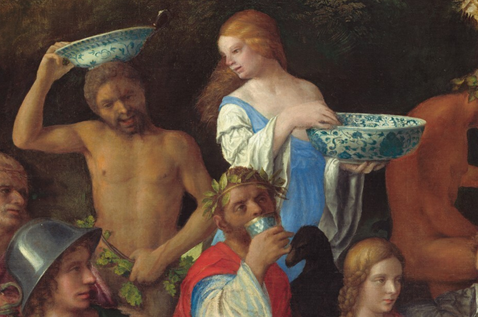If you had a trade secret, would you share it?

Continuing the distinctive blue on white aesthetic of the high period Ming pottery
Would you hold it tight and mystify European potters and nobility instead?
This is what China became known for in the 15th century as the routes of trade opened once more. The Age of Discovery unlocked new modes of trade with Asia, and European high society was graced by luxuries that had never before been seen of such quality and quantity. Gold and silver ornaments, Indonesian spices, worked ivory all began to flow in great quantities, but what was exceptionally influential at the time was the pottery appearing from China. At this time, the Chinese had pioneered firing and mixing techniques that were not employed anywhere else on the continents. They had developed a proprietary blend of materials in kaolin (a silicate clay mineral), porcelain stone, feldspar and quartz. Coupled with their exceptionally hot firing techniques, also a mystery to Europeans at the time, they produced a form of pottery that was remarkable and unlike anything available at the time.
Thus, porcelain was born!
The components that made up the raw porcelain were unique in that they vitrified upon firing. Functionally, this resulted in a finished product that was completely waterproof when unglazed. It took to painting and glazing beautifully, with few of the imperfections common in earthen and stoneware. It was hard, with a unique glasslike toughness but delicate and a brilliant white at the same time. This form of pottery would remain a Chinese secret for at least 200 more years, with their European counterparts working furiously to unravel the mystery of what gave it such unique properties.

An example of the monochrome blue decorative elements common in Ming pottery at the time
A Fragile Juggernaut
Meanwhile, in Jingdezhen the Ming Dynasty was dawning. An Imperial factory was established, marking a hotbed for the production of these artifacts that would burn strong through the entirety of its reign. They developed a distinct aesthetic, embracing the brilliant white colour of the fired works, painting them in monochrome blues and intricate motifs before glazing them with a glassy sheen. The finest works would be stamped with the mark of the reigning emperor himself, they were held in such high esteem. These blue and white exports would become the primary export into Europe, beginning a craze that would later birth the Chinoiserie phenomenon with Europeans attempting to imitate the aesthetics of the Chinese craftsmen.

An example of a Ming jug, with a distinct Islamic influence in the design.

We can see in “The Feast of the Gods” (1514) by Bellini and Titian Ming pottery was so highly regarded, it began to appear as status symbols in art at the time
The Ming Dynasty would continue to export these wares for the next two centuries on a scale unprecedented, continuing until the end of their reign in 1620. The kilns of Jingdezhen would work tirelessly as masters of their secret crafts until Europeans could manage to create pottery works of similar caliber two centuries later.
Lecture Reflection
This was an interesting one for me, we got to touch on a few things that I’d been curious about from Jeff’s class, but didn’t get to linger overly long on (some of the works of Durer, and additional insights into manuscripts, marginalia, and illuminated early books). I learned a good deal about the subtleties of typefaces, particularly classic looking Roman ones, which I was largely ignorant of. It was interesting to reflect on how important the size and spacing of these fonts is, less so the stylistic differences, but that’s because I’m less of a design nerd and more of an illustration one! I’ll learn to pick the differences out soon I’m sure. We also touched on what’s probably my least favorite period in terms of aesthetic considerations (Rococo), I hate to admit but the incredibly powdered, gilded frippery on everything just makes me want to gag, I find it to almost be like the aesthetic equivalent of a clown horn. That’s probably because I’m an uncultured pleb though, so… grain of salt!
Sourcing:
http://www.comuseum.com/ceramics/ming/
https://www.britannica.com/art/Chinese-pottery/The-Ming-dynasty-1368-1644
The Silk Road Encyclopedia, Jeong, Su-il. Irvine, California : Seoul Selection, 2016
Image Credits:
http://www.alaintruong.com/archives/2016/12/29/34740504.html
https://p7.storage.canalblog.com/77/42/119589/114046142_o.jpg

Leave a Reply